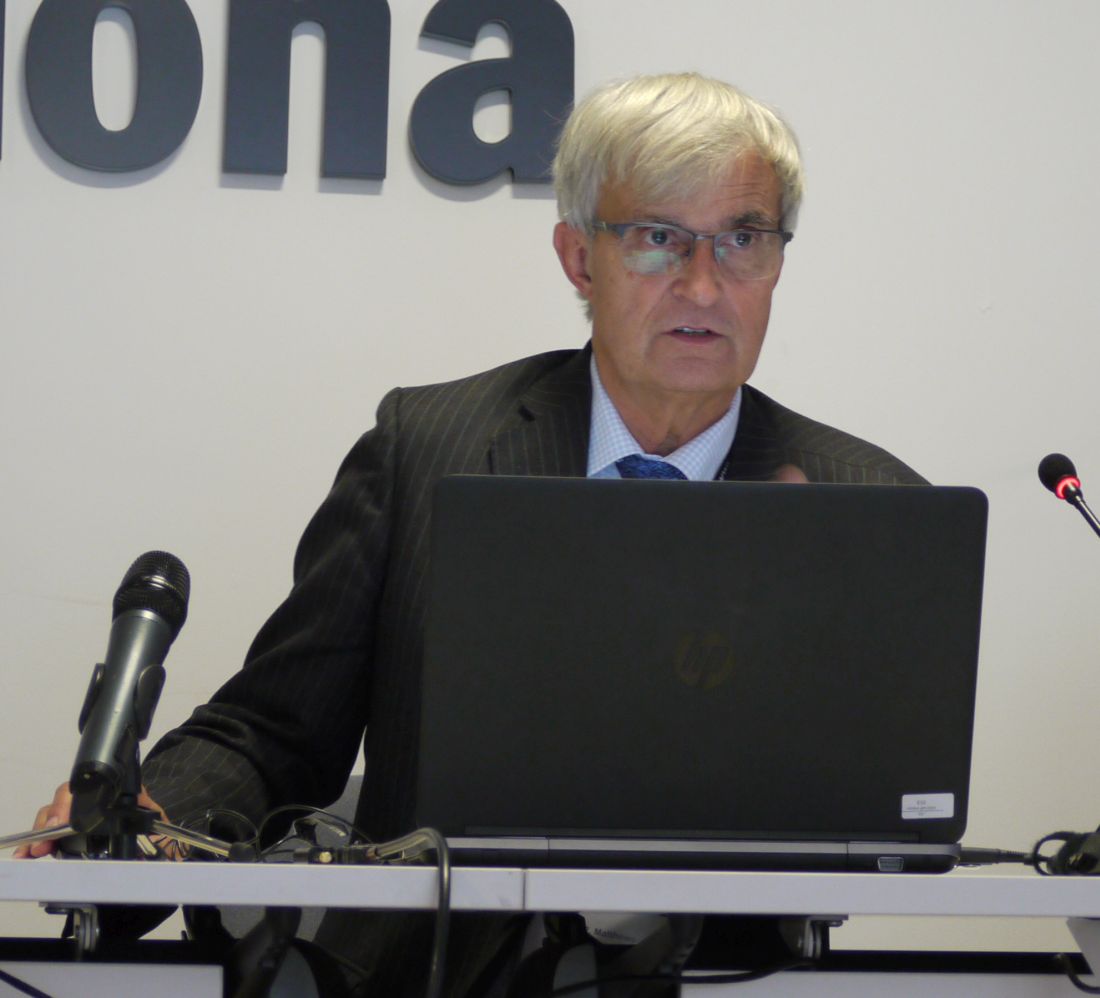User login
BARCELONA – Upfront use of a dual combination of vildagliptin (Galvus) and metformin was associated with better and more durable glycemic control than metformin alone in patients with newly diagnosed type 2 diabetes, according to findings reported at the annual meeting of the European Association for the Study of Diabetes.
Fewer patients treated with the combination than with metformin monotherapy experienced “treatment failure” (43.6% vs. 62.1%, respectively) during the initial study period. The time-to-treatment failure, which was defined as an hemoglobin A1c of at least 7% (53 mmol/L) or higher on two occasions 3 months apart, was estimated to be beyond the study’s duration, at 61·9 months, for the combination and a median of 36.1 months in the monotherapy group.
Moreover, there was a significant (P less than .0001) 49% reduction in the relative risk for the time-to-initial-treatment failure in the early combination treatment group, compared with the monotherapy group, during the 5-year study period. The time-to-second-treatment failure was also longer in patients who received initial combination therapy (hazard ratio, 0.74; P less than .0001).
These results of the VERIFY (Vildagliptin Efficacy in Combination With Metformin for Early Treatment of Type 2 Diabetes) study, which were published simultaneously in the Lancet, provide the first real evidence to support the use of combination therapy rather than the current standard of metformin alone in the initial treatment of type 2 diabetes.
VERIFY was a phase 4, randomized, parallel-group study designed to compare the durability of glycemic control achieved with a combination of vildagliptin plus metformin or metformin alone in treatment-naive patients with type 2 diabetes.
At a press briefing, three members of the VERITY steering committee explained the rationale, design, results, and implications of the study.
EASD president David R. Matthews, DPhil, FRCP, who is emeritus professor at the Oxford Centre for Diabetes, Endocrinology and Metabolism at the University of Oxford (England), observed that the study aimed to answer three important questions: Do patients with type 2 diabetes benefit from having combination treatment from the start of their pharmacologic management, and if so, is this more beneficial than a step-up approach, and ultimately, “does it really matter?”
A typical cohort of patients was included, said Michael Stumvoll, MD, of the University Hospital Leipzig (Germany). Patients had to be aged between 18 and 70 years, have a body mass index of 22-40 kg/m2, and an hemoglobin A1c level of 6.5%-7.5%. This “rather narrow range” was decided “on purpose to really fulfill the idea of having newly diagnosed [type 2 diabetes]”, Dr. Stumvoll noted. In addition, patients had to have adequate renal function, have been diagnosed with type 2 diabetes in the past 2 years, and be drug naive or have received no more than 4 weeks of metformin.
In all, 2,001 patients from 254 centers in 34 countries were included, with 998 randomized to initial treatment with vildagliptin and metformin and 1,003 to receive metformin alone after an initial run-in phase during which the dose of metformin was up-titrated from 500 to 1,500 mg/day. The study ran for 5 years, with treatment intensified if there was a loss of glycemic control at the discretion of the study investigators – first vildagliptin was added to patients taking metformin monotherapy, then insulin, if needed.
There were no safety concerns: A similar percentage of patients in the early combination and initial monotherapy arms experienced an adverse event (83.5% vs. 83.2%, respectively), a serious adverse event (16.6% vs. 18.3%), a drug-related adverse event (15.9% vs. 14.3%), a severe adverse event (10.5% vs. 10.6%), and adverse events leading to discontinuation of treatment (4.1% vs. 5.3%) or death (13 vs. 9 patients). There was no difference in the change in body weight, and rates of hypoglycemia were 1.3% and 0.9%, respectively.
Adjudication and an independent data-monitoring committee were set up after cardiovascular events occurred in a few patients, although this was not a cardiovascular outcomes trials, Dr. Matthews stressed. There were fewer absolute cumulative adjudicated events in the early combination arm, compared with the initial monotherapy arm (30 vs. 44, respectively), and the time to the first adjudicated macrovascular event favored early combination over initial monotherapy (2.4% vs. 3.3%; HR, 0.71).
“There is a big caveat here,” said Dr. Matthews, “these are very small numbers and wide confidence intervals and the P value is .194.” Although “it is not a significant finding, and it was never intended to be a significant finding,” it gives “an indication that we absolutely should be looking at this.”
Stefano Del Prato, MD, of the University of Pisa (Italy), noted that “there has been a lot of discussion around initial combination therapy for type 2 diabetes,” and although there was a realization that multiple treatment might be necessary, there was no evidence for that. The results of the VERIFY trial, however, now provide some of the proof that this approach may be of benefit. Patients “benefit twice as much” with the combination therapy as they do with the monotherapy, Dr. Del Prato said. “There are twice as many patients retained under control with an early combination, compared with the monotherapy.” That means no longer “running after the patient losing control” he said, but “being proactive” and with a very low risk of hypoglycemia. The clinical implication is that there is now evidence for combination therapy as an initial approach for managing type 2 diabetes.
Novartis funded the study. Dr. Matthews has served on advisory boards or as a consultant for, and has given lectures for, Novartis and numerous other companies not related to the study. He is currently the president of the European Association for the Study of Diabetes. Dr. Stumvoll has received speaker's honoraria and consulting fees from Novartis and other companies. Dr. Del Prato serves or has served on advisory boards and speakers bureaus for, and received research support from, Novartis and numerous other companies.
SOURCE: Matthews DR et al. Lancet. 2019 Sept 18. doi: 10.1016/ S0140-6736(19)32131-2.
This article was updated on 9/19/2019.
BARCELONA – Upfront use of a dual combination of vildagliptin (Galvus) and metformin was associated with better and more durable glycemic control than metformin alone in patients with newly diagnosed type 2 diabetes, according to findings reported at the annual meeting of the European Association for the Study of Diabetes.
Fewer patients treated with the combination than with metformin monotherapy experienced “treatment failure” (43.6% vs. 62.1%, respectively) during the initial study period. The time-to-treatment failure, which was defined as an hemoglobin A1c of at least 7% (53 mmol/L) or higher on two occasions 3 months apart, was estimated to be beyond the study’s duration, at 61·9 months, for the combination and a median of 36.1 months in the monotherapy group.
Moreover, there was a significant (P less than .0001) 49% reduction in the relative risk for the time-to-initial-treatment failure in the early combination treatment group, compared with the monotherapy group, during the 5-year study period. The time-to-second-treatment failure was also longer in patients who received initial combination therapy (hazard ratio, 0.74; P less than .0001).
These results of the VERIFY (Vildagliptin Efficacy in Combination With Metformin for Early Treatment of Type 2 Diabetes) study, which were published simultaneously in the Lancet, provide the first real evidence to support the use of combination therapy rather than the current standard of metformin alone in the initial treatment of type 2 diabetes.
VERIFY was a phase 4, randomized, parallel-group study designed to compare the durability of glycemic control achieved with a combination of vildagliptin plus metformin or metformin alone in treatment-naive patients with type 2 diabetes.
At a press briefing, three members of the VERITY steering committee explained the rationale, design, results, and implications of the study.
EASD president David R. Matthews, DPhil, FRCP, who is emeritus professor at the Oxford Centre for Diabetes, Endocrinology and Metabolism at the University of Oxford (England), observed that the study aimed to answer three important questions: Do patients with type 2 diabetes benefit from having combination treatment from the start of their pharmacologic management, and if so, is this more beneficial than a step-up approach, and ultimately, “does it really matter?”
A typical cohort of patients was included, said Michael Stumvoll, MD, of the University Hospital Leipzig (Germany). Patients had to be aged between 18 and 70 years, have a body mass index of 22-40 kg/m2, and an hemoglobin A1c level of 6.5%-7.5%. This “rather narrow range” was decided “on purpose to really fulfill the idea of having newly diagnosed [type 2 diabetes]”, Dr. Stumvoll noted. In addition, patients had to have adequate renal function, have been diagnosed with type 2 diabetes in the past 2 years, and be drug naive or have received no more than 4 weeks of metformin.
In all, 2,001 patients from 254 centers in 34 countries were included, with 998 randomized to initial treatment with vildagliptin and metformin and 1,003 to receive metformin alone after an initial run-in phase during which the dose of metformin was up-titrated from 500 to 1,500 mg/day. The study ran for 5 years, with treatment intensified if there was a loss of glycemic control at the discretion of the study investigators – first vildagliptin was added to patients taking metformin monotherapy, then insulin, if needed.
There were no safety concerns: A similar percentage of patients in the early combination and initial monotherapy arms experienced an adverse event (83.5% vs. 83.2%, respectively), a serious adverse event (16.6% vs. 18.3%), a drug-related adverse event (15.9% vs. 14.3%), a severe adverse event (10.5% vs. 10.6%), and adverse events leading to discontinuation of treatment (4.1% vs. 5.3%) or death (13 vs. 9 patients). There was no difference in the change in body weight, and rates of hypoglycemia were 1.3% and 0.9%, respectively.
Adjudication and an independent data-monitoring committee were set up after cardiovascular events occurred in a few patients, although this was not a cardiovascular outcomes trials, Dr. Matthews stressed. There were fewer absolute cumulative adjudicated events in the early combination arm, compared with the initial monotherapy arm (30 vs. 44, respectively), and the time to the first adjudicated macrovascular event favored early combination over initial monotherapy (2.4% vs. 3.3%; HR, 0.71).
“There is a big caveat here,” said Dr. Matthews, “these are very small numbers and wide confidence intervals and the P value is .194.” Although “it is not a significant finding, and it was never intended to be a significant finding,” it gives “an indication that we absolutely should be looking at this.”
Stefano Del Prato, MD, of the University of Pisa (Italy), noted that “there has been a lot of discussion around initial combination therapy for type 2 diabetes,” and although there was a realization that multiple treatment might be necessary, there was no evidence for that. The results of the VERIFY trial, however, now provide some of the proof that this approach may be of benefit. Patients “benefit twice as much” with the combination therapy as they do with the monotherapy, Dr. Del Prato said. “There are twice as many patients retained under control with an early combination, compared with the monotherapy.” That means no longer “running after the patient losing control” he said, but “being proactive” and with a very low risk of hypoglycemia. The clinical implication is that there is now evidence for combination therapy as an initial approach for managing type 2 diabetes.
Novartis funded the study. Dr. Matthews has served on advisory boards or as a consultant for, and has given lectures for, Novartis and numerous other companies not related to the study. He is currently the president of the European Association for the Study of Diabetes. Dr. Stumvoll has received speaker's honoraria and consulting fees from Novartis and other companies. Dr. Del Prato serves or has served on advisory boards and speakers bureaus for, and received research support from, Novartis and numerous other companies.
SOURCE: Matthews DR et al. Lancet. 2019 Sept 18. doi: 10.1016/ S0140-6736(19)32131-2.
This article was updated on 9/19/2019.
BARCELONA – Upfront use of a dual combination of vildagliptin (Galvus) and metformin was associated with better and more durable glycemic control than metformin alone in patients with newly diagnosed type 2 diabetes, according to findings reported at the annual meeting of the European Association for the Study of Diabetes.
Fewer patients treated with the combination than with metformin monotherapy experienced “treatment failure” (43.6% vs. 62.1%, respectively) during the initial study period. The time-to-treatment failure, which was defined as an hemoglobin A1c of at least 7% (53 mmol/L) or higher on two occasions 3 months apart, was estimated to be beyond the study’s duration, at 61·9 months, for the combination and a median of 36.1 months in the monotherapy group.
Moreover, there was a significant (P less than .0001) 49% reduction in the relative risk for the time-to-initial-treatment failure in the early combination treatment group, compared with the monotherapy group, during the 5-year study period. The time-to-second-treatment failure was also longer in patients who received initial combination therapy (hazard ratio, 0.74; P less than .0001).
These results of the VERIFY (Vildagliptin Efficacy in Combination With Metformin for Early Treatment of Type 2 Diabetes) study, which were published simultaneously in the Lancet, provide the first real evidence to support the use of combination therapy rather than the current standard of metformin alone in the initial treatment of type 2 diabetes.
VERIFY was a phase 4, randomized, parallel-group study designed to compare the durability of glycemic control achieved with a combination of vildagliptin plus metformin or metformin alone in treatment-naive patients with type 2 diabetes.
At a press briefing, three members of the VERITY steering committee explained the rationale, design, results, and implications of the study.
EASD president David R. Matthews, DPhil, FRCP, who is emeritus professor at the Oxford Centre for Diabetes, Endocrinology and Metabolism at the University of Oxford (England), observed that the study aimed to answer three important questions: Do patients with type 2 diabetes benefit from having combination treatment from the start of their pharmacologic management, and if so, is this more beneficial than a step-up approach, and ultimately, “does it really matter?”
A typical cohort of patients was included, said Michael Stumvoll, MD, of the University Hospital Leipzig (Germany). Patients had to be aged between 18 and 70 years, have a body mass index of 22-40 kg/m2, and an hemoglobin A1c level of 6.5%-7.5%. This “rather narrow range” was decided “on purpose to really fulfill the idea of having newly diagnosed [type 2 diabetes]”, Dr. Stumvoll noted. In addition, patients had to have adequate renal function, have been diagnosed with type 2 diabetes in the past 2 years, and be drug naive or have received no more than 4 weeks of metformin.
In all, 2,001 patients from 254 centers in 34 countries were included, with 998 randomized to initial treatment with vildagliptin and metformin and 1,003 to receive metformin alone after an initial run-in phase during which the dose of metformin was up-titrated from 500 to 1,500 mg/day. The study ran for 5 years, with treatment intensified if there was a loss of glycemic control at the discretion of the study investigators – first vildagliptin was added to patients taking metformin monotherapy, then insulin, if needed.
There were no safety concerns: A similar percentage of patients in the early combination and initial monotherapy arms experienced an adverse event (83.5% vs. 83.2%, respectively), a serious adverse event (16.6% vs. 18.3%), a drug-related adverse event (15.9% vs. 14.3%), a severe adverse event (10.5% vs. 10.6%), and adverse events leading to discontinuation of treatment (4.1% vs. 5.3%) or death (13 vs. 9 patients). There was no difference in the change in body weight, and rates of hypoglycemia were 1.3% and 0.9%, respectively.
Adjudication and an independent data-monitoring committee were set up after cardiovascular events occurred in a few patients, although this was not a cardiovascular outcomes trials, Dr. Matthews stressed. There were fewer absolute cumulative adjudicated events in the early combination arm, compared with the initial monotherapy arm (30 vs. 44, respectively), and the time to the first adjudicated macrovascular event favored early combination over initial monotherapy (2.4% vs. 3.3%; HR, 0.71).
“There is a big caveat here,” said Dr. Matthews, “these are very small numbers and wide confidence intervals and the P value is .194.” Although “it is not a significant finding, and it was never intended to be a significant finding,” it gives “an indication that we absolutely should be looking at this.”
Stefano Del Prato, MD, of the University of Pisa (Italy), noted that “there has been a lot of discussion around initial combination therapy for type 2 diabetes,” and although there was a realization that multiple treatment might be necessary, there was no evidence for that. The results of the VERIFY trial, however, now provide some of the proof that this approach may be of benefit. Patients “benefit twice as much” with the combination therapy as they do with the monotherapy, Dr. Del Prato said. “There are twice as many patients retained under control with an early combination, compared with the monotherapy.” That means no longer “running after the patient losing control” he said, but “being proactive” and with a very low risk of hypoglycemia. The clinical implication is that there is now evidence for combination therapy as an initial approach for managing type 2 diabetes.
Novartis funded the study. Dr. Matthews has served on advisory boards or as a consultant for, and has given lectures for, Novartis and numerous other companies not related to the study. He is currently the president of the European Association for the Study of Diabetes. Dr. Stumvoll has received speaker's honoraria and consulting fees from Novartis and other companies. Dr. Del Prato serves or has served on advisory boards and speakers bureaus for, and received research support from, Novartis and numerous other companies.
SOURCE: Matthews DR et al. Lancet. 2019 Sept 18. doi: 10.1016/ S0140-6736(19)32131-2.
This article was updated on 9/19/2019.
REPORTING FROM EASD 2019



